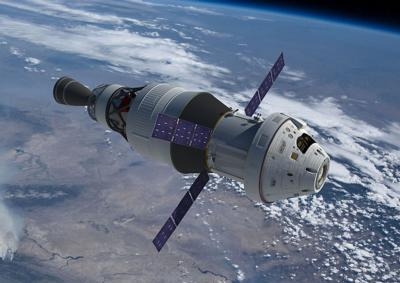ICPS To Fly On First Orion Mission
Some elements of a rocket can be familiar, like the boosters and engines. But there are several important parts on NASA's new rocket, the Space Launch System (SLS), that may be less widely known. Case in point? The interim cryogenic propulsion stage (ICPS).

If the SLS was dissected, the ICPS lies just below the Orion capsule, at the top of the SLS. The ICPS is a liquid oxygen/liquid hydrogen-based system. On the first test mission of Orion and SLS together, called Exploration Mission-1, the ICPS will give Orion the big push that would be needed to fly beyond the moon before the spacecraft returns to Earth. For later long-duration missions in deep space, this interim stage will be replaced with a more powerful upper stage on SLS needed to carry crews and their spacecraft farther than ever before, including to an asteroid and ultimately Mars.
Orion will serve as the exploration vehicle that will carry the crew to space, provide emergency abort capability, sustain the crew during the space travel, and provide safe re-entry from deep space return velocities.
For the ICPS, The Boeing Co. will modify its existing Delta Cryogenic Second Stage, used on United Launch Alliance’s Delta IV family of launch vehicles. It will be powered by an Aerojet Rocketdyne RL-10B2 engine -- also currently used on the Delta Cryogenic Second Stage.
"Boeing's Delta Cryogenic Second Stage will need relatively minor modifications to be fully compliant with SLS requirements, which will keep us on schedule for the first two flights," said Chris Calfee, ICPS project manager at NASA's Marshall Space Flight Center in Huntsville, Alabama. Marshall manages the SLS Program for the agency.
Those modifications include lengthening the liquid hydrogen tank, adding hydrazine bottles for attitude control and making some minor avionics changes to meet the design parameters and performance characteristics as needed by NASA to meet the flight objectives.

"Affordability is key when a rocket as big and powerful as the SLS is needed for sustainable deep space exploration," said Steve Creech, assistant SLS Program manager for strategy and partnerships at Marshall. "By using existing hardware and technology, we aim to create a multipurpose vehicle that can demonstrate the capabilities of this flexible system on early mission objectives."
NASA’s baseline plan is to use an ICPS for SLS on the uncrewed Exploration Mission-1, with an option for a second ICPS that may be used for a crewed Exploration Mission-2. NASA continues to examine its timeline for integrating an upper stage and evolving SLS towards a 143 ton version that will send humans to Mars.
NASA recently signed a contract agreement with Boeing for the ICPS -- completing all definitization contracts for the major SLS elements. The interim cryogenic propulsion stage is managed under the SLS Program by the Spacecraft and Payload Integration and Evolution Office at Marshall.
The first flight test of the SLS will feature a configuration for a 77-ton lift capacity and carry an uncrewed Orion spacecraft beyond low-Earth orbit to test the performance of the integrated system. As the SLS evolves, it will provide an unprecedented lift capability of 143 tons to enable missions even farther into our solar system.
(Image provided by NASA: Top: Artist concept of the Orion spacecraft. The ICPS will boost the Orion to the correct altitude and trajectory needed to send the spacecraft around the moon in order to check out vital systems during the initial test flights. SLS launch pictured in NASA artist's rendering)
 ANN's Daily Aero-Term (04.26.24): DETRESFA (Distress Phrase)
ANN's Daily Aero-Term (04.26.24): DETRESFA (Distress Phrase) Aero-News: Quote of the Day (04.26.24)
Aero-News: Quote of the Day (04.26.24) ANN's Daily Aero-Term (04.27.24): Direct
ANN's Daily Aero-Term (04.27.24): Direct ANN's Daily Aero-Linx (04.27.24)
ANN's Daily Aero-Linx (04.27.24) Aero-News: Quote of the Day (04.27.24)
Aero-News: Quote of the Day (04.27.24)




